Cichlids are an unusually wide group of freshwater fish found on virtually every continent of the planet. Currently, almost two thousand species have been described, and many scientists agree that this is far from the limit. Among the Tsikhlov family, you can find a wide variety of fish, differing in size, body shape, color, and type of food. It is not surprising that many of them have become well-deserved aquarium favorites.
Acara turquoise
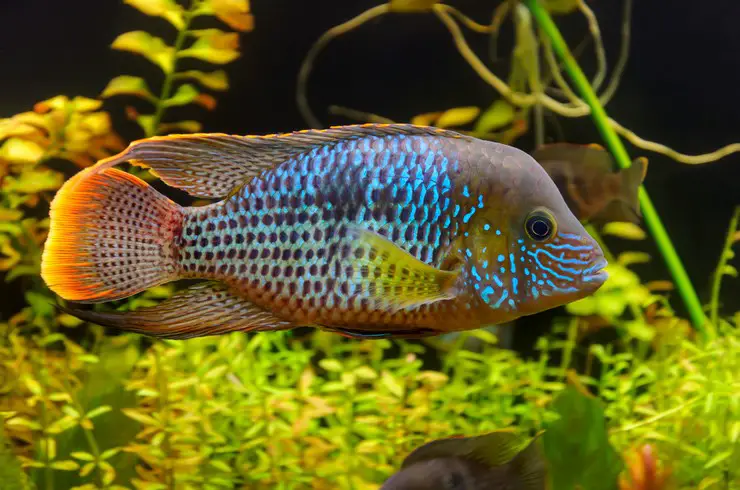
An excellent representative of the large South American cichlids. It is prized, first of all, for its unusual coloration: bluish-green scales and spots flaunt on the silvery-gray body, and the tail and back fins have bright yellow or white edging.
The fish can grow up to 25-30 cm, therefore, to maintain a pair of cancers, you will need an aquarium with a volume of at least 300 liters. Unfortunately, this beautiful fish has an absurd character, and it is not without reason that it is called the “green terror”. Very often, akara shows aggression towards neighbors in the aquarium, especially during the spawning period. Therefore, it is necessary to keep them only with commensurate cichlids, and the aquarium should have sufficient volume and a large number of shelters.
Astronotus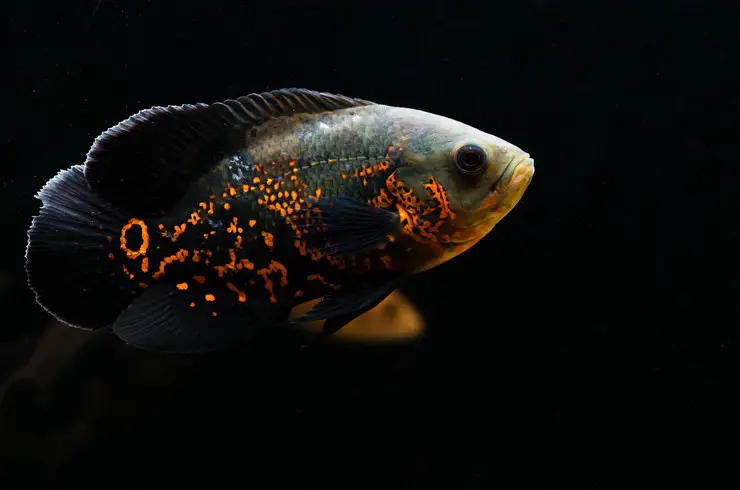
Astronotuses found their way into hobbyist aquariums from rivers in South America. It is enough to look at this fish to immediately identify a real predator in it: a streamlined body shape, a pointed mouth, powerful fins. Small fish and invertebrates form the basis of their diet in nature.
Astronotuses belong to large cichlids: in a suitable volume, a fish can grow up to 25-30 cm without any problems. Their color is very beautiful – on a black body, bright orange spots are evenly located, sometimes forming stripes. The anal and dorsal fins are brought close to each other, forming a kind of “fan”. Thanks to the efforts of breeders, various color forms have been obtained. You can find red Astronotuses, in which the orange-red color is evenly distributed throughout the body, or albinos with red spots on a white background.
It is desirable that at least 100 liters of a waterfall on one adult. A species aquarium is best suited for astronotuses, but in general, the fish get along well with other commensurate cichlids.
Aquarists note the extraordinary courtesy of astronotuses, they quickly remember their owner and follow with pleasure what is happening in the room.
Blue dolphin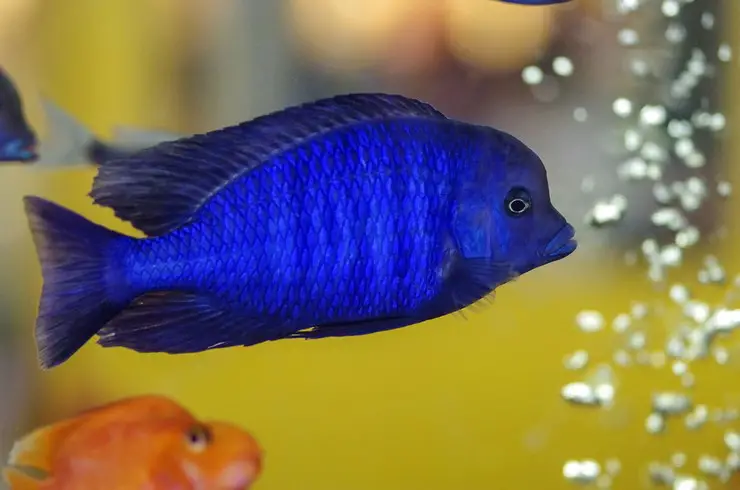
The blue dolphin is native to the African continent and is one of the largest cichlids in Lake Malawi. The fish got its name for the extraordinary similarity of adult males with known marine mammals. The cichlid is distinguished by a rich blue body color and a characteristic fatty build-up on the head.
It is best to keep fish in groups of one male and several females. In this case, it will be possible to avoid conflicts between males. The blue dolphin is not very aggressive and coexists well with African cichlids of the corresponding size.
The water in Lake Malawi is clean and quite hard, which must be taken into account when keeping blue dolphins.
Discus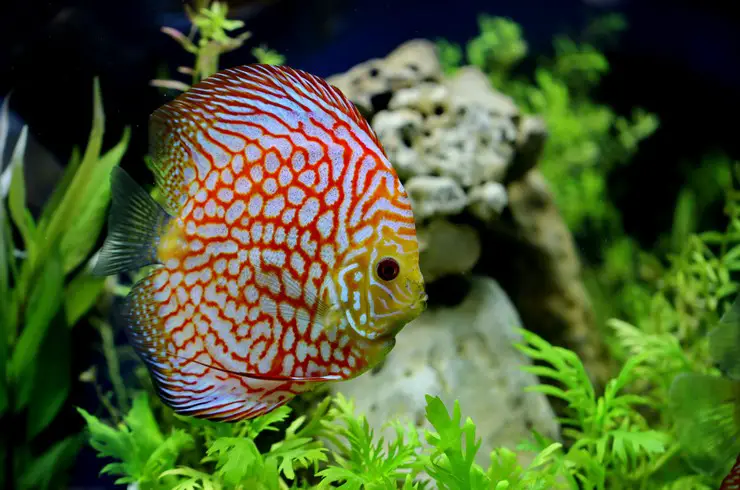
Discus is interesting cichlids from South America. Their distinctive features are, first of all, an almost rounded body shape and an amazing coloration. Over the years of breeding, an astonishing number of color variations of discus have been obtained, so every aquarist will definitely find a fish to his taste.
But keeping discus at home has certain difficulties. The thing is that they are very sensitive to water parameters and feeding. Best of all, if the discus lives in groups of 6 or more, the optimal aquarium for such a number of inhabitants will be a capacity of 400-500 liters. The water in the aquarium should be soft and warm enough – 30-32 ° C, which narrows the range of possible roommates, because not every species can withstand such a high temperature. Of course, high-quality filtration and aeration are required, as well as regular water changes.
Particular attention should be paid to feeding. With an unbalanced diet, fish can get digestive problems and lose their wonderful color. Therefore, it is best to choose specialized dry food for discus – Tetra Discus.
Discus can be bred at home, fish have very developed care for offspring. Of particular interest is the feeding of newborn fry with a special secret, which is released on the skin of both the male and the female.
Labidochromis yellow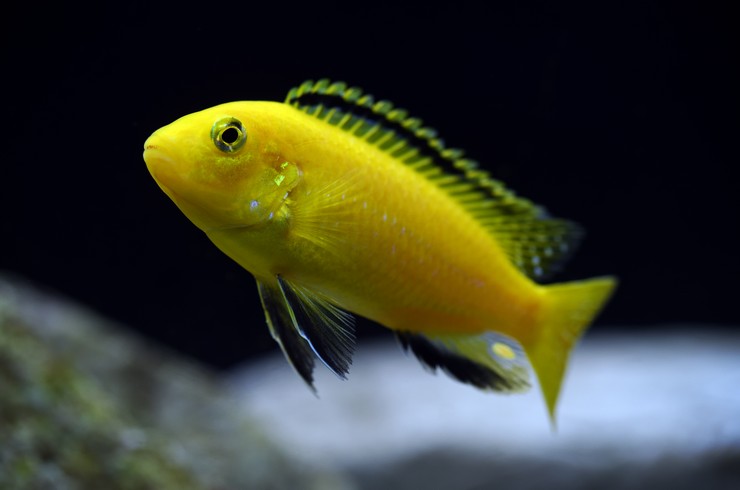
Already in the name of this wonderful cichlid its main feature is reflected – “yellow” in English means “yellow”. After all, it is in a bright lemon-yellow color that this inhabitant of the African lake Malawi is painted. Dark pectoral and pelvic fins, as well as a black stripe on the long dorsal fin, give additional expressiveness.
In addition to its flamboyant appearance, labidochromis yellow is peaceful compared to most of its other relatives and often gets along well with many medium-sized species.
It is best to keep fish in groups of a male and several females in aquariums from 100 liters. It is best to design an aquarium in a minimalist style: sandy soil, driftwood, stones, a minimum of living plants – which is closest to the natural landscapes of Lake Malawi.
We must not forget that labidochromis fellow belongs to the Mbuna group. These are cichlids, which in their natural environment feed mainly on algal growths on rocks, which means that plant components, for example, spirulina algae, must be present in the fish diet.
Melanochromis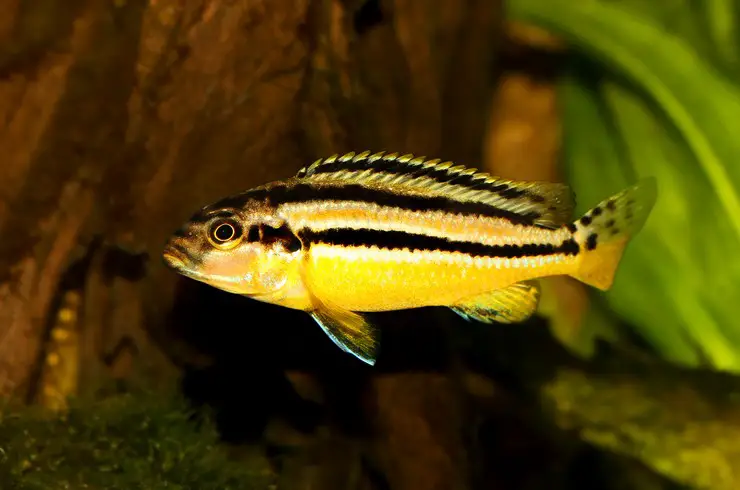
Melanochromis are cichlids originating from Lake Malawi. This reservoir is famous for its huge variety of cichlids, many of which do not even have a scientific description yet. However, melanachromis have long won the hearts of aquarists. First of all, they are very beautiful. The most common species with yellow and blue body color. Stripes running from head to tail are a characteristic feature.
Unfortunately, Melachromis are very territorial and some of the most aggressive Malawian cichlids. To ensure the possibility of keeping with other cichlids, you need to think about a large aquarium, which will be divided into zones with decorations, so that each fish has its own territory.
Pronounced aggressiveness by novice rich lovers is often viewed as a sign of a predator, and therefore the fish are fed accordingly – food with a high content of animal proteins. Unfortunately, this often leads to diseases of melanochromis, because the basis of the diet of these fish should be vegetation.
Melanochromis is characterized by caring for the offspring. After fertilization of the eggs, the female incubates it in the mouth, and even after hatching the fry protects her offspring for several months.
Pelvicachromis pulcher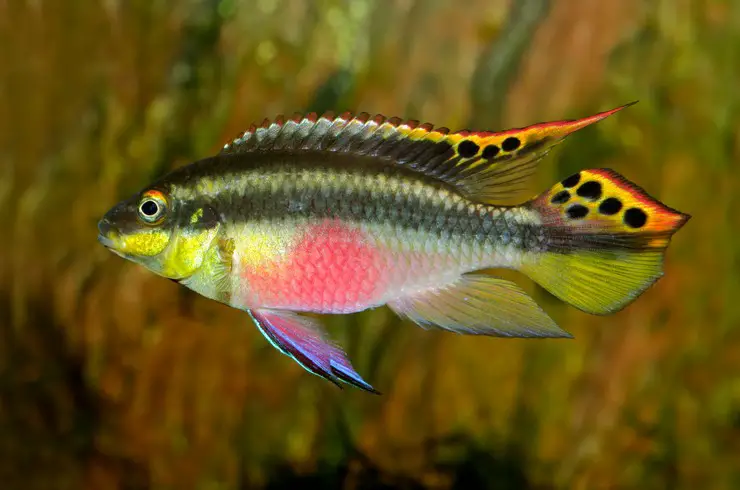
Pelvicachromis pulcher, better known as the parrot cichlid, is found naturally in the rivers of Africa. This fish has a rather modest size (no more than 10 cm), but its color is just an explosion of color: you can find brown, yellow, red, blue, and other colors. And on the tail, oval black spots are often found. It is hard to believe that these fish fries have an unsightly silvery color with black heels. However, in nature, this allows babies to hide more effectively at the bottom.
Pelvicachromis are also valued for their peaceful nature, they are well compatible with most medium-sized ornamental fish. The only time when fish catch up with fear on neighbors is during the spawning period. By the way, it is also quite simple to get offspring from pelvicachromis at home.
To keep a pair of pelvicachromis, you need an aquarium of 40 liters or more. Fish look great among living plants, to which they are quite indifferent.
Parrotfish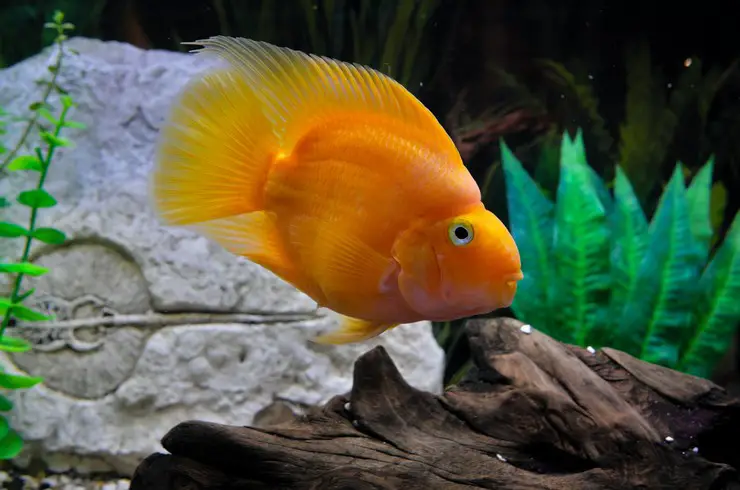
The parrotfish is the result of the work of Taiwanese breeders who managed to get an interesting hybrid of several South American cichlids, but which ones are still unknown, this is a commercial secret. Despite its origins, many aquarists have liked the fish. Their amusing barrel-shaped body shape, slight awkwardness, and characteristic “smile” on the face attract attention. The most common color is red, but fish are artificially dyed in more exotic colors, such as blue or green.
For keeping you will need a large enough aquarium because parrots can grow up to 25-30 cm. The character of the fish depends on the specific individual and the conditions of detention. Usually, compatibility problems with proportional cichlids do not arise, although sometimes quite aggressive individuals come across that survive all neighbors. It is best to raise fish together from a young age, then the number of conflicts is noticeably reduced.
Parrotfish are able to create pairs and even lay eggs, which, however, are sterile, and it will not be possible to get fry from them naturally.
Scalar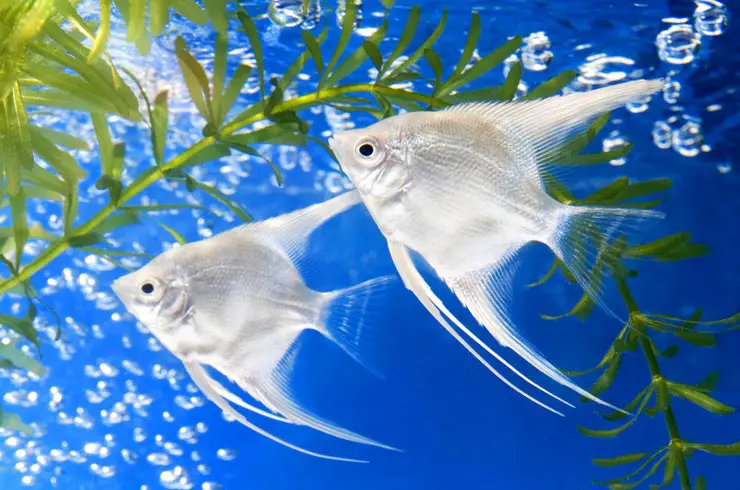
Scalaria is without a doubt the most popular aquarium cichlid. These beautiful fish with an unusual “triangular” body shape have a huge army of fans around the world.
Angelfish live in the rivers of South America, their flat body with elongated fins allows them to effectively hide among thickets of plants.
For the maintenance of scalars, it is better to take care of an aquarium of 100 liters per pair. It is in this volume that the fish will be able to reach their maximum size and reveal all their beauty. It is best to arrange an aquarium in a natural style – with driftwood and live plants.
Scalarians are quite peaceful cichlids and go well even with small species of ornamental fish such as neons or tetras.
At present, through the efforts of breeders, many varieties of scalars have been obtained, differing in color and degree of development of fins.
Cichlazoma black-striped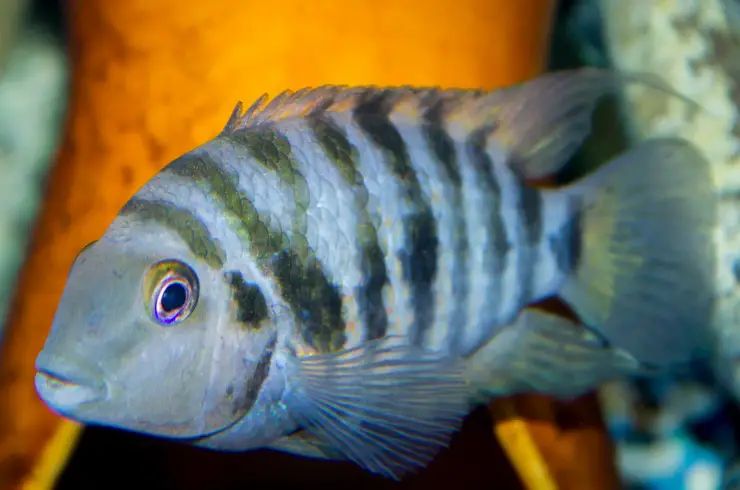
Black-striped cichlazomas cannot boast of bright coloration or any outstanding feature. This is a fairly “standard” cichlid with a grayish body and transverse dark stripes. However, the popularity of this fish does not suffer from this at all. This is most likely due to the high endurance of the cichlazoma, its small size (about 10 cm), and ease of reproduction. And the aggressiveness of black-striped cichlazoma is not so pronounced, especially if fish are kept in a spacious aquarium.
It is very important that the cichlazes have enough shelter, then each pair of fish will have its own territory. In suitable conditions, representatives of this species are able to live for 8-10 years.
